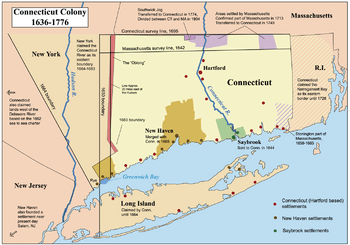Saybrook Colony facts for kids
Quick facts for kids
Saybrook Colony
|
|||||||
|---|---|---|---|---|---|---|---|
| 1635–1644 | |||||||

Map of Connecticut annotated to show its colonial history and the establishment of its modern borders
|
|||||||
| Status | Colony of England | ||||||
| Capital | Old Saybrook | ||||||
| Common languages | English | ||||||
| Religion | Puritanism | ||||||
| Government | Constitutional monarchy | ||||||
| History | |||||||
|
• Established
|
1635 | ||||||
|
• merged with Connecticut Colony
|
1644 | ||||||
| Currency | Pound sterling | ||||||
|
|||||||
The Saybrook Colony was an early English colony in North America. It was founded in late 1635 at the mouth of the Connecticut River. Today, this area is known as Old Saybrook, Connecticut.
John Winthrop the Younger, son of the Governor of the Massachusetts Bay Colony, led its creation. He was named Governor by the first settlers. These settlers included Colonel George Fenwick and Captain Lion Gardiner. They claimed the land through a special document from Robert Rich, the Earl of Warwick. The colony was named after Lords Saye and Brooke. They were important English leaders and owned the land grants for the colony.
Contents
History of Saybrook Colony
Early Plans and Challenges
The first people who settled in Saybrook Colony strongly supported Oliver Cromwell. Cromwell was a powerful leader in England who believed in democracy. In the 1630s, there were rumors that Cromwell and other important Puritan leaders might move from England to Saybrook. These leaders included John Pym, John Hampden, Arthur Haselrig, and Lords Saye and Brooke. Even many years later, people in Old Saybrook still talked about which land plots would be given to these famous English leaders.
To prepare for these important settlers, a ship was sent with unusual items. It carried ironwork for a portcullis (a strong gate) and drawbridges. An experienced military engineer also came along. The fort at Saybrook was planned to be the strongest in New England.
However, the plans for these leaders to move to Saybrook changed. By 1638, the idea was given up. Cromwell and the other sponsors stayed in England. They played important roles in the English Civil War. Because these key leaders did not come, the colony faced difficulties.
Merger and Fort Protection
By 1644, George Fenwick, one of the original settlers, agreed to a merger. Saybrook Colony joined with the Connecticut Colony, which was a stronger settlement a few miles up the river.
In 1647, Major John Mason took charge of Saybrook Fort. This fort was very important because it controlled the main trade and supply route for the river valley. The fort mysteriously burned down, but a new, improved one was quickly built nearby. Major Mason lived there for twelve years. He served as a leader for the New England Confederation, a group of united colonies. He was also a chief military officer, a judge, and a peacemaker. He often helped settle disagreements between Native American tribes and fairly arranged land purchases.
Slavery in the Colony
Slavery played a role in the economy of the Saybrook Colony. It helped some of the colony's leaders gain wealth. Enslaved people in the colony were mainly descendants of Africans from the Caribbean. Some were also Native American prisoners from the Pequot War. They worked in many important industries. These included farming, shipbuilding, and making ropes. These activities were part of the Triangle Trade system.
From 1662 to 1800, about 60 people in Saybrook owned enslaved individuals. The highest number of enslaved people was in the 1740s, when Nathaniel Lynde owned 10. By 1800, only six owners remained. In 1797, laws were passed to free all enslaved people once they reached 21 years of age. However, it took longer for all enslaved people in Connecticut to gain complete freedom, which happened in 1848.
See also
 In Spanish: Colonia de Saybrook para niños
In Spanish: Colonia de Saybrook para niños


